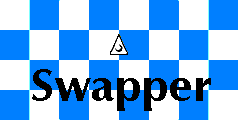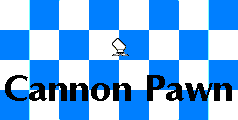
 The Advancer moves
passively as an Orthodox Queen. In order to capture, the Advancer
must move to a square adjacent to an enemy piece. If the next square
in the direction it moved from the square the Advancer stopped on is
occupied by an opposing piece, that opposing piece is captured. (This
is capture by approach.) These captures are part of movement,
and are not optional -- you can not move a Advancer next to an
opposing piece in the line of movement and not capture it.
An Advancer never moves into an occupied square. An Advancer may only
enter an edge square if swapped there, but once on an edge square it
may make capturing moves along the edge.
The Advancer moves
passively as an Orthodox Queen. In order to capture, the Advancer
must move to a square adjacent to an enemy piece. If the next square
in the direction it moved from the square the Advancer stopped on is
occupied by an opposing piece, that opposing piece is captured. (This
is capture by approach.) These captures are part of movement,
and are not optional -- you can not move a Advancer next to an
opposing piece in the line of movement and not capture it.
An Advancer never moves into an occupied square. An Advancer may only
enter an edge square if swapped there, but once on an edge square it
may make capturing moves along the edge.
In the diagram to the left, the White Advancer requires four separate moves to capture the three Cannon Pawns.

 The Long Leaper moves as an Orthodox Queen and
captures by overtaking. It
takes possession of a single intervening
piece by leaping to a vacant square somewhere beyond it. It may
capture additional pieces, along the same line, if a vacant 'landing
square' lies somewhere beyond each enemy piece. A Long Leaper may
never jump over a friendly piece, jump over adjacent pieces, or move
to an occupied square. It may end its move on an edge square only when
that is the only way to make a particular capture.
The Long Leaper moves as an Orthodox Queen and
captures by overtaking. It
takes possession of a single intervening
piece by leaping to a vacant square somewhere beyond it. It may
capture additional pieces, along the same line, if a vacant 'landing
square' lies somewhere beyond each enemy piece. A Long Leaper may
never jump over a friendly piece, jump over adjacent pieces, or move
to an occupied square. It may end its move on an edge square only when
that is the only way to make a particular capture.
In the diagram to the left, the Black Long Leaper captures the four White Cannon Pawns in three moves.

 The Swapper moves as an Orthodox Queen without
capturing, or may swap position with any piece (of either side)
an unobstructed Queen's move away. A Swapper's swap move counts as a
capture for the purpose of the edge squares, so a Swapper may swap
position with a piece on an edge square. Additionally, a Swapper may
capture an adjacent piece and itself at the same time by mutual
destruction. Mutual destruction may not be used when immobilized.
If a Swapper swaps with an opposing Swapper or Chameleon, on the
following turn the two pieces may not swap back. They may swap again
once any other move is made.
The Swapper moves as an Orthodox Queen without
capturing, or may swap position with any piece (of either side)
an unobstructed Queen's move away. A Swapper's swap move counts as a
capture for the purpose of the edge squares, so a Swapper may swap
position with a piece on an edge square. Additionally, a Swapper may
capture an adjacent piece and itself at the same time by mutual
destruction. Mutual destruction may not be used when immobilized.
If a Swapper swaps with an opposing Swapper or Chameleon, on the
following turn the two pieces may not swap back. They may swap again
once any other move is made.
In the diagram to the left, the White swapper uses two moves to swap positions with Cannon pawns, initially swapping positions with an enemy piece, then swapping positions with a friendly piece. For it's third move, it mutually destructs with the adjacent Black Cannon pawn.

 The Withdrawer moves
passively as an Orthodox Queen. In order to capture, the
Withdrawer must occupy a square adjacent to an enemy piece. To
complete the capture, it must move one-or-more squares directly away
from the enemy piece. For example, a Withdrawer moving from d2 to g2
captures only an enemy piece at c2 (not c3/d3/e3/c1/d1/e1). These
captures are part of movement, and are not optional -- you can not
move a Withdrawer directly away from an opposing piece and
not capture it. A Withdrawer may never move to an occupied
square. It may move to an edge square when it is the only way to make
a particular capture.
The Withdrawer moves
passively as an Orthodox Queen. In order to capture, the
Withdrawer must occupy a square adjacent to an enemy piece. To
complete the capture, it must move one-or-more squares directly away
from the enemy piece. For example, a Withdrawer moving from d2 to g2
captures only an enemy piece at c2 (not c3/d3/e3/c1/d1/e1). These
captures are part of movement, and are not optional -- you can not
move a Withdrawer directly away from an opposing piece and
not capture it. A Withdrawer may never move to an occupied
square. It may move to an edge square when it is the only way to make
a particular capture.
In the diagram to the left, the Black Withdrawer requires three separate moves to capture the three Black Cannon pawns.

 The Immobilizer moves as an Orthodox Queen but does
not capture. An enemy piece standing adjacent to an Immobilizer may
not move while the Immobilizer is present. Black and white
Immobilizers, occupying adjacent squares, are each frozen until the
other is captured. An immobilized piece other than a King may 'commit
suicide' by removing itself from the board (usually to open a line of
attack). This counts as a move for the player removing the piece. The
Immobilizer may never move to an occupied square or an edge square
(although it may be swapped to an edge square).
The Immobilizer moves as an Orthodox Queen but does
not capture. An enemy piece standing adjacent to an Immobilizer may
not move while the Immobilizer is present. Black and white
Immobilizers, occupying adjacent squares, are each frozen until the
other is captured. An immobilized piece other than a King may 'commit
suicide' by removing itself from the board (usually to open a line of
attack). This counts as a move for the player removing the piece. The
Immobilizer may never move to an occupied square or an edge square
(although it may be swapped to an edge square).
In the diagram to the left, the Black Immobilizer uses its move to not only prevent the Black King from being captured, but also ensures that the White King can be captured the next turn.

 The Chameleon moves passively as an Orthodox
Queen. To capture, it mimics the powers of its intended victim. For
example, it leaps over a mount to capture a Pawn, withdraws from
Withdrawers, approaches Advancers, leaps over Long Leapers, and swaps
with Swappers. By the same token, an enemy King standing adjacent to a
Chameleon can be captured by the Chameleon. Chameleons can freeze
Immobilizers but cannot capture them (but when next to an Immobilizer
do not freeze any other pieces). A Chameleon next to a Swapper may
capture it (and itself) by mutual destruction.
The Chameleon moves passively as an Orthodox
Queen. To capture, it mimics the powers of its intended victim. For
example, it leaps over a mount to capture a Pawn, withdraws from
Withdrawers, approaches Advancers, leaps over Long Leapers, and swaps
with Swappers. By the same token, an enemy King standing adjacent to a
Chameleon can be captured by the Chameleon. Chameleons can freeze
Immobilizers but cannot capture them (but when next to an Immobilizer
do not freeze any other pieces). A Chameleon next to a Swapper may
capture it (and itself) by mutual destruction.
A Chameleon can use multiple types of capture in the same move. Consider a white Withdrawer on a1, a black Chameleon on a2, a white Long Leaper on a3 and a white Advancer on a5. The Black Chameleon by leaping over the Long Leaper to a4 would also capture the white Withdrawer by moving away from it, and the white Advancer by approaching it (for purposes of approaching and withdrawing it doesn't matter if the move is a slide or a leap).
In the diagram to the left, the White Chameleon (with a single move) captures the Black Withdrawer (by moving directly away from it), captures the Black Long Leaper (by leaping over it), captures the Black Advancer (by approaching it), and swaps positions with the Black Swapper. Also note that at the end of its move, the White Chameleon immobilizes the Black Immobilizer, and would be threatening the Black King if the Chameleon itself were not immobilized by the Black Immobilizer.

 The Pawns in Rococo are Cannon Pawns, since
their move is rather like a limited form of the Cannon from XiangQi (although, their move is even
more like the fairy Chess piece called the Grasshopper).
Cannon Pawns move without capturing two ways: either a single step in
any direction, or, they may leap over an adjacent piece of either side
to the empty square just beyond. They capture the in the second way
they move, by leaping over an adjacent piece (the mount), landing on
the opposing piece just beyond the mount. A Cannon Pawn may only move
to an edge square when capturing a piece on an edge square.
The Pawns in Rococo are Cannon Pawns, since
their move is rather like a limited form of the Cannon from XiangQi (although, their move is even
more like the fairy Chess piece called the Grasshopper).
Cannon Pawns move without capturing two ways: either a single step in
any direction, or, they may leap over an adjacent piece of either side
to the empty square just beyond. They capture the in the second way
they move, by leaping over an adjacent piece (the mount), landing on
the opposing piece just beyond the mount. A Cannon Pawn may only move
to an edge square when capturing a piece on an edge square.
In the diagram to the left, the White Cannon pawn uses its first move to leap over a White Cannon pawn. It then makes a non-capturing diagonal move, and finally, leaps over the Black Advancer to capture the Black Cannon pawn.